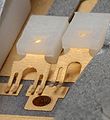Cam switches: Difference between revisions
No edit summary |
No edit summary |
||
| Line 1: | Line 1: | ||
Cam switches are used in many Tek instruments, particularly in [[7000-series plug-ins]], but also in 400-series portable scopes. | Cam switches are used in many Tek instruments, particularly in [[7000-series plug-ins]], but also in [[TM500]] equipment and 400-series portable scopes. | ||
The lobes on the rotary cam encode the lookup table of which contacts should be open or closed in each rotational position of the shaft, | The lobes on the rotary cam encode the lookup table of which contacts should be open or closed in each rotational position of the shaft, | ||
which is typically rotated by a knob on the front panel of the instrument. | which is typically rotated by a knob on the front panel of the instrument. | ||
A benefit of this design is low parasitics compared to traditional rotary wafer switches. | A benefit of this design is low parasitics compared to traditional rotary wafer switches. | ||
For cleaning, Tek recommends swiping paper soaked in isopropyl alcohol between the contacts and pads. | |||
==Maintenance== | ==Maintenance== | ||
| Line 21: | Line 23: | ||
[[Category:Repair issues]] | [[Category:Repair issues]] | ||
[[Category:Electromechanical components]] | |||
Revision as of 08:46, 30 December 2016
Cam switches are used in many Tek instruments, particularly in 7000-series plug-ins, but also in TM500 equipment and 400-series portable scopes.
The lobes on the rotary cam encode the lookup table of which contacts should be open or closed in each rotational position of the shaft, which is typically rotated by a knob on the front panel of the instrument. A benefit of this design is low parasitics compared to traditional rotary wafer switches.
For cleaning, Tek recommends swiping paper soaked in isopropyl alcohol between the contacts and pads.
Maintenance
Pictures
-
Cam switch in 7A19
-
Cam switch in 7A19
-
Cam switch in 7A19, contact fingers (isolated from spring lever)
-
Cam switch with contacts on both sides of the PCB (7D15)
-
7D15 double-sided switch
-
7D15 double-sided switch
-
7D15 double-sided switch, bottom-side contacts
-
7D15 double-sided switch, through-board pins







